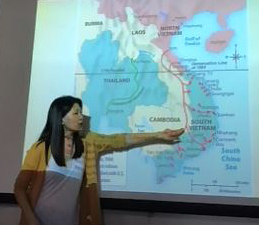The History of US Immigration Laws: What Students Should Know
by Jane Hong
The history of US immigration laws can be boiled down to a single question: Who gets to be an American and who does not? This question encompasses who can immigrate to the country, who can stay, and who can become naturalized. We could provide our students a sterile list of all the major federal laws that together made the US immigration system what it is today—it would essentially begin with the 1882 Chinese Exclusion Act and conclude with any number of recent milestones—but they are unlikely to find that interesting. Given that, what should our students know about this history?

The weeklong format forced me to pare down a semester’s worth of content from my “Immigrants in America” course into just a few digestible take-home lessons. As a native of the East Coast, I had never taken an explicitly Californian approach to the material before. Thinking deeply about where and how the state’s immigration history fit—and just as often, did not fit—within a national story led me to the points below. I believe they offer a good starting point for thinking about what our students should know about the history of American immigration policy.
Here are some of the points I gleaned, both in preparing that course and in teaching it:

The second point is related: The federal government did not restrict immigration or systematically police US borders until the late nineteenth and early twentieth centuries, but this does not mean that immigration was fully unchecked. In the absence of federal immigration restrictions in America’s early decades, many state and even territorial governments took it upon themselves to try to keep immigrants out. For example, both New York and Massachusetts had regulations in the mid-nineteenth century designed to prevent or discourage poor Irish Catholics from entering through their ports. Historians have argued that these ordinances, a response to the Irish famine migrations, laid the groundwork for federal immigration policies decades later. In the West, Oregon and California also tried to restrict who could enter their borders, but with less success. From 1848 to 1854, it was illegal for any “Negro” or “mulatto” to reside within Oregon Territory. 
My third point relates closely to my second: Gatekeeping was a process rather than a one-time event. Congressional lawmakers, administrative officials, and others in government created and enacted restrictions, while people on the ground enforced them. Restricting immigration—whether by race, nationality, or other criteria—was a messy, complex process. For example, and not surprisingly, communities sometimes challenged their exclusion. Chinese immigrants became especially well known for their strategies of circumventing legal barriers after exclusion. For example, they created the “paper son” system, in which they used false identities and documentation to gain entry by claiming kinship with Chinese American US citizens; the practice lasted from the 1880s through the 1950s.
In another example showing how complex gatekeeping was, US borders with Mexico and Canada were constructed over time. No matter how clear their intentions, immigration policies enacted in Washington DC—hundreds of miles from either border—were rarely straightforward in practice. Historians have charted how the many small decisions and practices of the Border Patrol and the Immigration and Naturalization Service (the precursors of today’s CIS and ICE) collectively constructed the border, helping transform it from what historian Rachel St. John has called a “line in the sand” into a highly militarized reality.
The final point I think all students should learn is that the immigration policies of yesterday are connected to those of today. It doesn’t take a lawyer to understand that when it comes to US immigration law, the past is not always past. Legal precedents establish principles or rules upon which future laws can build. As a result, past immigration policies do not simply inspire future ones; in many cases, they form the bases that make additional laws possible. Recognizing this, many immigration historians have begun writing news pieces intended to educate the public about the historical policies and practices that continue to shape our legal system. These can be useful teaching tools, a clear reminder for students (and indeed, for all of us) of how America’s immigration history is relevant to our lives today.
Jane Hong is an assistant professor of history at Occidental College in Los Angeles. Her first book, Opening the Gates to Asia: A Transpacific History of How America Repealed Asian Exclusion, will be published in Fall 2019 by the University of North Carolina Press. Hong’s next project explores intersections of race, post-1965 immigration, religion, and partisanship using the history of Asian American evangelicals since the 1970s.











































































